Quote of the Day:
"We think in generalities, but we live in details."
-- Alfred North Whitehead
Objectives:
The student will determine the area under a curve by
summing up rectangles.
1. Collect Homework.
2. Today, we will find areas under curves (i.e., between
the curve and the x-axis). We will sum up the areas of
rectangles which approximate the area under the curve.
We will use several different techniques:
(1) Using the left-hand endpoints
(2) Using the right-hand endpoints
(3) Using inscribed rectangles
(4) Using the circumscribed rectangles
The figure below shows how to compute the area under the
curve by using the left-hand endpoints.
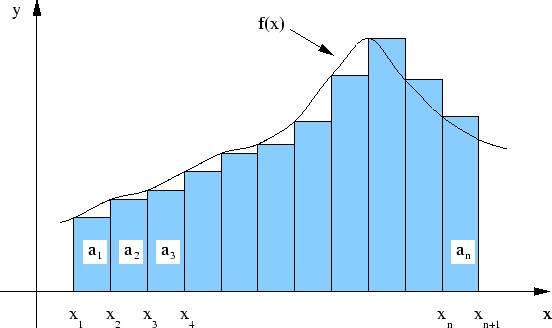 What happens as we increase the number of rectangles?
3. Example:
Determine the area under the curve y = x + 1 on the
interval [0, 2] in three different ways:
(1) Approximate the area by finding areas of
rectangles where the height of the rectangle is
the y-coordinate of the left-hand endpoint
(2) Approximate the area by finding areas of
rectangles where the height of the rectangle is
the y-coordinate of the right-hand endpoint
(3) Find the exact area under the curve using
geometry
#1 Using left hand endpoints and 4 rectangles:
(in this example, these are also called
inscribed rectangles)
What happens as we increase the number of rectangles?
3. Example:
Determine the area under the curve y = x + 1 on the
interval [0, 2] in three different ways:
(1) Approximate the area by finding areas of
rectangles where the height of the rectangle is
the y-coordinate of the left-hand endpoint
(2) Approximate the area by finding areas of
rectangles where the height of the rectangle is
the y-coordinate of the right-hand endpoint
(3) Find the exact area under the curve using
geometry
#1 Using left hand endpoints and 4 rectangles:
(in this example, these are also called
inscribed rectangles)
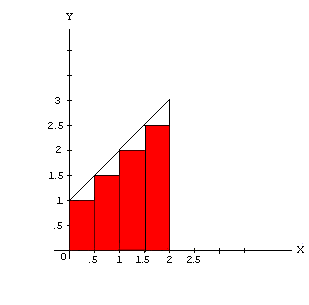 Area = (.5)(1) + (.5)(1.5) + (.5)(2) + (.5)(2.5)
= .5 + .75 + 1 + 1.25 = 3.5 square units
#2 Using right hand endpoints and 4 rectangles:
(in this example, these are also circumscribed
rectangles)
Area = (.5)(1) + (.5)(1.5) + (.5)(2) + (.5)(2.5)
= .5 + .75 + 1 + 1.25 = 3.5 square units
#2 Using right hand endpoints and 4 rectangles:
(in this example, these are also circumscribed
rectangles)
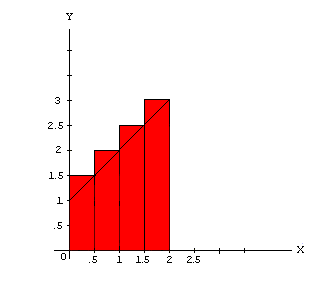 Area = (.5)(1.5) + (.5)(2) + (.5)(2.5) + (.5)(3)
= .75 + 1 + 1.25 + 1.5 = 4.5 square units
#3 Using geometry to find the exact area under the
curve:
The figure is a trapezoid, so use the formula
for the area of a trapezoid:
Area = Average of the Bases x Height or
Area = (.5)(1.5) + (.5)(2) + (.5)(2.5) + (.5)(3)
= .75 + 1 + 1.25 + 1.5 = 4.5 square units
#3 Using geometry to find the exact area under the
curve:
The figure is a trapezoid, so use the formula
for the area of a trapezoid:
Area = Average of the Bases x Height or
 Note that the average of the first two methods (the
inscribed and circumscribed rectangles) gives the exact
area under the curve. This only works because the curve
is a straight line.
4. Later in the year, we will use other numerical methods
to find areas under curves — Simpson's Rule and the
Trapezoidal Rule. Simpson's Rule uses parabolas to
approximate the area under the curve and the Trapezoidal
Rule uses trapezoids to approximate the area.
In general, if we wish to determine the area under the following curve,
Note that the average of the first two methods (the
inscribed and circumscribed rectangles) gives the exact
area under the curve. This only works because the curve
is a straight line.
4. Later in the year, we will use other numerical methods
to find areas under curves — Simpson's Rule and the
Trapezoidal Rule. Simpson's Rule uses parabolas to
approximate the area under the curve and the Trapezoidal
Rule uses trapezoids to approximate the area.
In general, if we wish to determine the area under the following curve,
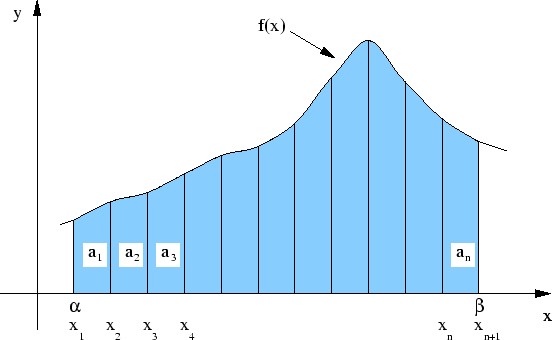 we could approximate it with rectangles like we did
above or we could approximate it with trapezoids like in
the diagram below:
we could approximate it with rectangles like we did
above or we could approximate it with trapezoids like in
the diagram below:
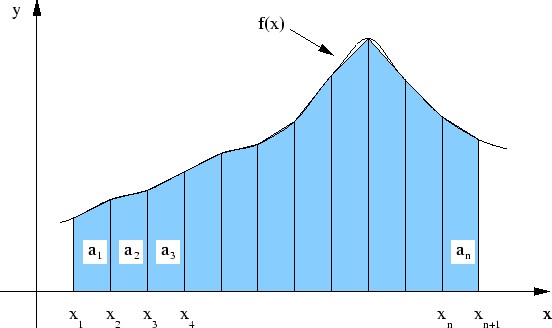 Notice that the trapezoidal approximation gives a more
accurate answer than the rectangular approximation.
Tomorrow, we will determine the exact area under the
curve by increasing the number of rectangles and then
applying a limit.
5. Assignment
Read pages 349-354
Page 382 (1, 3, 5, 7) use n = 6
Notice that the trapezoidal approximation gives a more
accurate answer than the rectangular approximation.
Tomorrow, we will determine the exact area under the
curve by increasing the number of rectangles and then
applying a limit.
5. Assignment
Read pages 349-354
Page 382 (1, 3, 5, 7) use n = 6
Click here to go to the next page
What happens as we increase the number of rectangles? 3. Example: Determine the area under the curve y = x + 1 on the interval [0, 2] in three different ways: (1) Approximate the area by finding areas of rectangles where the height of the rectangle is the y-coordinate of the left-hand endpoint (2) Approximate the area by finding areas of rectangles where the height of the rectangle is the y-coordinate of the right-hand endpoint (3) Find the exact area under the curve using geometry #1 Using left hand endpoints and 4 rectangles: (in this example, these are also called inscribed rectangles)
Area = (.5)(1) + (.5)(1.5) + (.5)(2) + (.5)(2.5) = .5 + .75 + 1 + 1.25 = 3.5 square units #2 Using right hand endpoints and 4 rectangles: (in this example, these are also circumscribed rectangles)
Area = (.5)(1.5) + (.5)(2) + (.5)(2.5) + (.5)(3) = .75 + 1 + 1.25 + 1.5 = 4.5 square units #3 Using geometry to find the exact area under the curve: The figure is a trapezoid, so use the formula for the area of a trapezoid: Area = Average of the Bases x Height or
Note that the average of the first two methods (the inscribed and circumscribed rectangles) gives the exact area under the curve. This only works because the curve is a straight line. 4. Later in the year, we will use other numerical methods to find areas under curves — Simpson's Rule and the Trapezoidal Rule. Simpson's Rule uses parabolas to approximate the area under the curve and the Trapezoidal Rule uses trapezoids to approximate the area. In general, if we wish to determine the area under the following curve,
we could approximate it with rectangles like we did above or we could approximate it with trapezoids like in the diagram below:
Notice that the trapezoidal approximation gives a more accurate answer than the rectangular approximation. Tomorrow, we will determine the exact area under the curve by increasing the number of rectangles and then applying a limit. 5. Assignment Read pages 349-354 Page 382 (1, 3, 5, 7) use n = 6